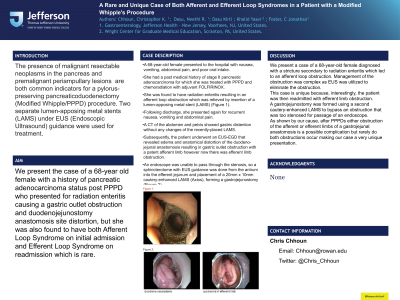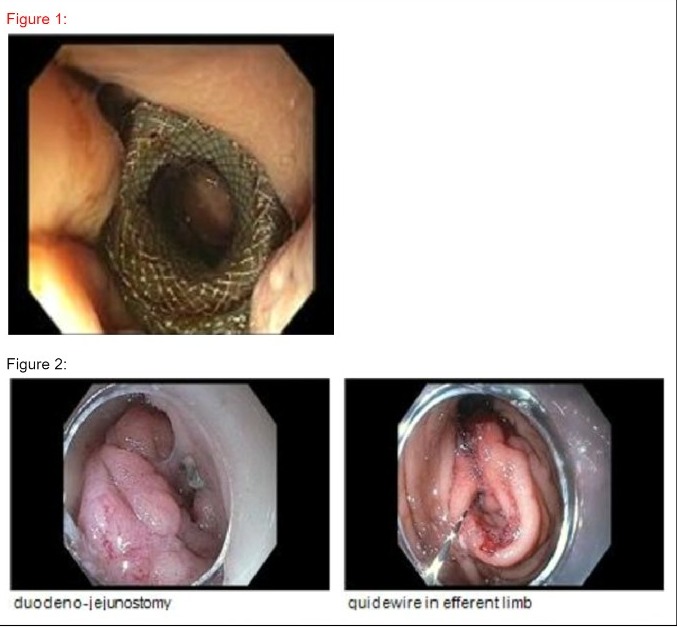Back


Poster Session B - Monday Morning
Category: Interventional Endoscopy
B0467 - A Rare and Unique Case of Both Afferent and Efferent Loop Syndromes in a Patient With a Modified Whipple's Procedure
Monday, October 24, 2022
10:00 AM – 12:00 PM ET
Location: Crown Ballroom

Has Audio

Christopher Chhoun, DO
Jefferson Health NJ
Voorhees, NJ
Presenting Author(s)
Christopher Chhoun, DO1, Neethi Dasu, DO2, Yaser Khalid, DO3, Kirti Dasu, BA4, C. Jonathan Foster, DO5
1Jefferson Health NJ, Voorhees, NJ; 2Jefferson Health New Jersey, Voorhees, NJ; 3Wright Center for GME/Geisinger Health System, Scranton, PA; 4Drexel Graduate School of Biomedical Sciences and Professional Studies, Philadelphia, PA; 5Jefferson Health New Jersey, Cherry Hill, NJ
Introduction: The presence of malignant resectable neoplasms in the pancreas and premalignant periampullary lesions are both common indicators for a pylorus-preserving pancreaticoduodenectomy (Modified Whipple/PPPD).We present the case of a 68-year old female with a history of pancreatic adenocarcinoma status post PPPD who presented for radiation enteritis causing a gastric outlet obstruction and duodenojejunostomy anastomosis site distortion, but she was also found to have both Afferent Loop Syndrome on initial admission and Efferent Loop Syndrome on readmission which is rare. Two separate lumen-apposing metal stents (LAMS) under EUS (Endoscopic Ultrasound) guidance were used for treatment.
Case Description/Methods: A 68-year-old female presented to the hospital with nausea, vomiting, abdominal pain, and poor oral intake. She had a past medical history of stage II pancreatic adenocarcinoma for which she was treated with PPPD and chemoradiation with adjuvant FOLFIRINOX. She was found to have radiation enteritis resulting in an afferent loop obstruction which was relieved by insertion of a lumen-apposing metal stent (LAMS)(Figure 1). Following discharge she presented again for recurrent nausea, vomiting and abdominal pain. A CT of the abdomen and pelvis showed gastric distention without any changes of the recently-placed LAMS. Subsequently the patient underwent an EUS-EGD that revealed edema and anatomical distortion of the duodeno-jejunal anastomosis resulting in gastric outlet obstruction with a patent afferent limb however now there was efferent limb obstruction. An endoscope was unable to pass through the stenosis, so a sphincterotome with EUS guidance was done from the antrum into the efferent jejunum and placement of a 20mm x 10mm cautery-enhanced LAMS (Axios), forming a gastrojejunostomy (Figure 2).
Discussion: We present a case of a 68-year-old female diagnosed with a stricture secondary to radiation enteritis which led to an afferent loop obstruction. Management was complex as EUS was utilized to eliminate the obstruction. This case is unique because interestingly, the patient was then readmitted with efferent limb obstruction. A gastrojejunostomy was formed using a second cautery-enhanced LAMS to bypass an obstruction that was too stenosed for passage of an endoscope. As shown by our cause, after PPPDs either obstruction of the afferent or efferent limbs of a gastrojejunal anastomosis is a possible complication but rarely do both obstructions occur making our case a very unique presentation.

Disclosures:
Christopher Chhoun, DO1, Neethi Dasu, DO2, Yaser Khalid, DO3, Kirti Dasu, BA4, C. Jonathan Foster, DO5. B0467 - A Rare and Unique Case of Both Afferent and Efferent Loop Syndromes in a Patient With a Modified Whipple's Procedure, ACG 2022 Annual Scientific Meeting Abstracts. Charlotte, NC: American College of Gastroenterology.
1Jefferson Health NJ, Voorhees, NJ; 2Jefferson Health New Jersey, Voorhees, NJ; 3Wright Center for GME/Geisinger Health System, Scranton, PA; 4Drexel Graduate School of Biomedical Sciences and Professional Studies, Philadelphia, PA; 5Jefferson Health New Jersey, Cherry Hill, NJ
Introduction: The presence of malignant resectable neoplasms in the pancreas and premalignant periampullary lesions are both common indicators for a pylorus-preserving pancreaticoduodenectomy (Modified Whipple/PPPD).We present the case of a 68-year old female with a history of pancreatic adenocarcinoma status post PPPD who presented for radiation enteritis causing a gastric outlet obstruction and duodenojejunostomy anastomosis site distortion, but she was also found to have both Afferent Loop Syndrome on initial admission and Efferent Loop Syndrome on readmission which is rare. Two separate lumen-apposing metal stents (LAMS) under EUS (Endoscopic Ultrasound) guidance were used for treatment.
Case Description/Methods: A 68-year-old female presented to the hospital with nausea, vomiting, abdominal pain, and poor oral intake. She had a past medical history of stage II pancreatic adenocarcinoma for which she was treated with PPPD and chemoradiation with adjuvant FOLFIRINOX. She was found to have radiation enteritis resulting in an afferent loop obstruction which was relieved by insertion of a lumen-apposing metal stent (LAMS)(Figure 1). Following discharge she presented again for recurrent nausea, vomiting and abdominal pain. A CT of the abdomen and pelvis showed gastric distention without any changes of the recently-placed LAMS. Subsequently the patient underwent an EUS-EGD that revealed edema and anatomical distortion of the duodeno-jejunal anastomosis resulting in gastric outlet obstruction with a patent afferent limb however now there was efferent limb obstruction. An endoscope was unable to pass through the stenosis, so a sphincterotome with EUS guidance was done from the antrum into the efferent jejunum and placement of a 20mm x 10mm cautery-enhanced LAMS (Axios), forming a gastrojejunostomy (Figure 2).
Discussion: We present a case of a 68-year-old female diagnosed with a stricture secondary to radiation enteritis which led to an afferent loop obstruction. Management was complex as EUS was utilized to eliminate the obstruction. This case is unique because interestingly, the patient was then readmitted with efferent limb obstruction. A gastrojejunostomy was formed using a second cautery-enhanced LAMS to bypass an obstruction that was too stenosed for passage of an endoscope. As shown by our cause, after PPPDs either obstruction of the afferent or efferent limbs of a gastrojejunal anastomosis is a possible complication but rarely do both obstructions occur making our case a very unique presentation.

Figure: Figure 1: Afferent loop obstruction relieved by insertion of a lumen-apposing metal stent (LAMS)
Figure 2: Efferent loop obstruction with guidewire
Figure 2: Efferent loop obstruction with guidewire
Disclosures:
Christopher Chhoun indicated no relevant financial relationships.
Neethi Dasu indicated no relevant financial relationships.
Yaser Khalid indicated no relevant financial relationships.
Kirti Dasu indicated no relevant financial relationships.
C. Jonathan Foster: conmed – Consultant. steris – Consultant.
Christopher Chhoun, DO1, Neethi Dasu, DO2, Yaser Khalid, DO3, Kirti Dasu, BA4, C. Jonathan Foster, DO5. B0467 - A Rare and Unique Case of Both Afferent and Efferent Loop Syndromes in a Patient With a Modified Whipple's Procedure, ACG 2022 Annual Scientific Meeting Abstracts. Charlotte, NC: American College of Gastroenterology.
